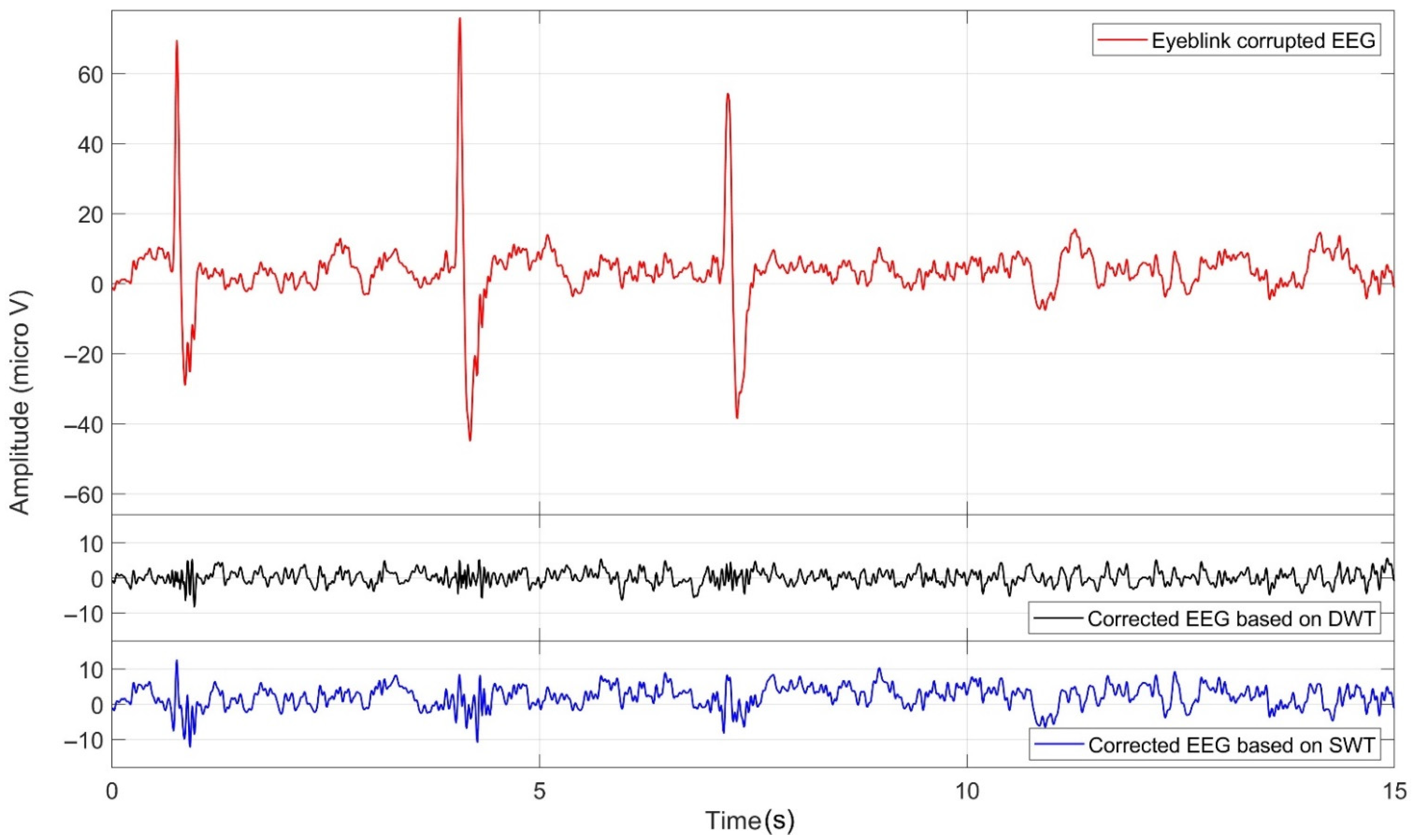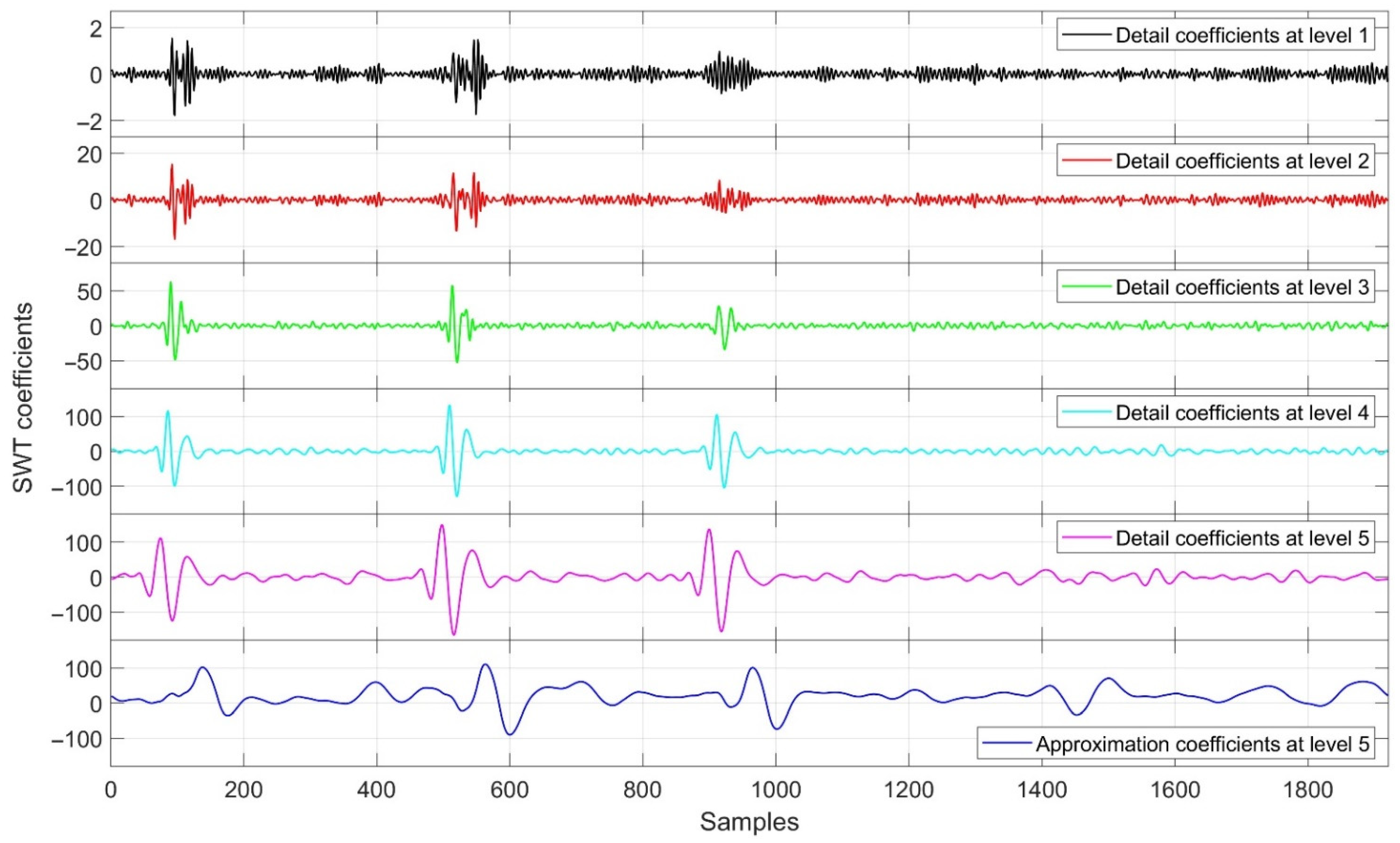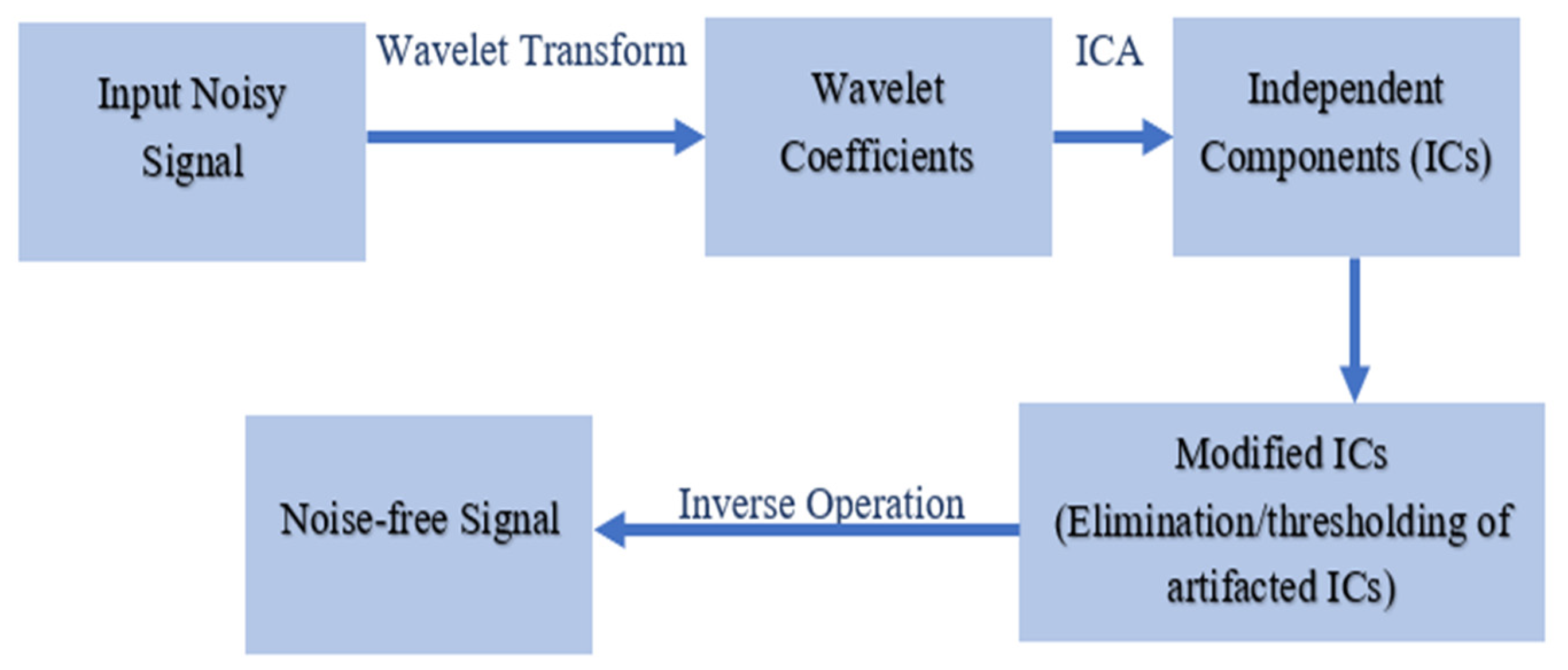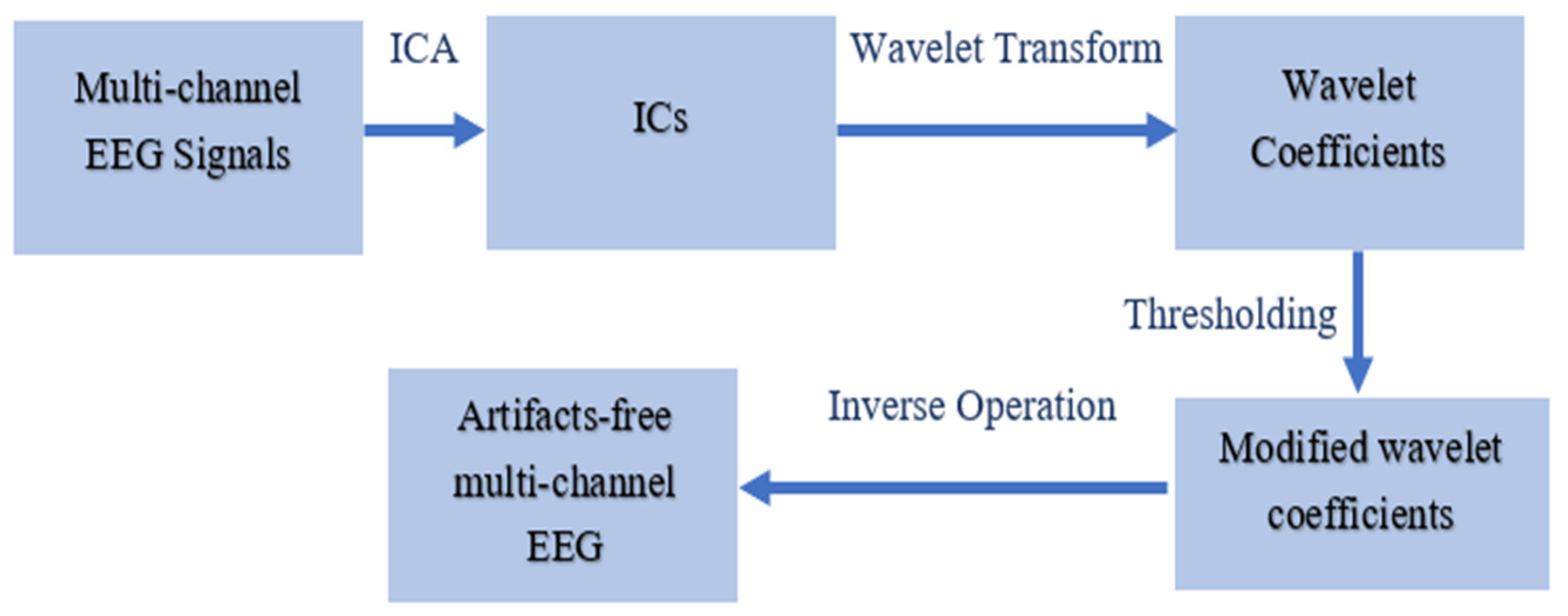A Survey on Denoising Techniques of Electroencephalogram Signals Using Wavelet Transform
Abstract
:1. Introduction
2. Wavelet Denoising
3. A Survey on Wavelet Transform-based EEG Denoising Techniques
3.1. Wavelet Denoising with Thresholding
3.2. Hybrid Methods with Wavelet Transform
3.3. Other Wavelet Transform-Based Method
4. Comparative Analysis
5. Conclusions
Funding
Institutional Review Board Statement
Informed Consent Statement
Conflicts of Interest
References
- Niedermeyer, E.; Silva, F.L.D. Electroencephalography: Basic Principles, Clinical Applications, and Related Fields; Lippincott Williams & Wilkins: Philadelphia, PA, USA, 2005. [Google Scholar]
- Ahmed, M.Z.I.; Sinha, N.; Phadikar, S.; Ghaderpour, E. Automated Feature Extraction on AsMap for Emotion Classification Using EEG. Sensors 2022, 22, 2346. [Google Scholar] [CrossRef]
- Im, C.H. Basics of EEG: Generation, Acquisition, and Applications of EEG. In Computational EEG Analysis; Springer: Singapore, 2018; pp. 3–11. [Google Scholar]
- Jiang, X.; Bian, G.B.; Tian, Z. Removal of Artifacts from EEG Signals: A Review. Sensors 2019, 19, 987. [Google Scholar] [CrossRef]
- Mumtaz, W.; Rasheed, S.; Irfan, A. Review of challenges associated with the EEG artifact removal methods. Biomed. Signal Process. Control. 2021, 68, 102741. [Google Scholar] [CrossRef]
- Croft, R.J.; Barry, R.J. Removal of ocular artifact from the EEG: A Review. Clin. Neurophysiol. 2000, 30, 5–19. [Google Scholar] [CrossRef]
- Kandaswamy, A.; Krishnaveni, V.; Jayaraman, S.; Malmurugan, N.; Ramadoss, K. Removal of ocular artifacts from EEG—A Survey. IETE J. Res. 2005, 51, 121–130. [Google Scholar] [CrossRef]
- Lai, C.Q.; Ibrahim, H.; Abdullah, M.Z.; Abdullah, J.M.; Suandi, S.A.; Azman, A. Artifacts and noise removal for electroencephalogram (EEG): A literature review. In Proceedings of the International Conference on Computer Applications and Industrial Electronics (ICCAIE), Penang, Malaysia, 28–29 April 2018; IEEE: Manhattan, NY, USA, 2018; pp. 326–332. [Google Scholar]
- Pereira, L.F.; Patil, S.A.; Mahadeshwar, C.D.; Mishra, I.; D’Souza, L. Artifact removal from EEG using ANFIS-GA. In Proceedings of the 2016 Online International Conference on Green Engineering and Technologies (IC-GET), Coimbatore, India, 19 November 2016; IEEE: Manhattan, NY, USA, 2016; pp. 1–6. [Google Scholar]
- Gratton, G.; Coles, M.G.; Donchin, E. A new method for off-line removal of ocular artifact. Electroencephalogr. Clin. Neurophysiol. 1983, 55, 468–484. [Google Scholar] [CrossRef]
- Zhang, J.H.; Janschek, K.; Böhme, J.F.; Zeng, Y.J. Multi-resolution dyadic wavelet denoising approach for extraction of visual evoked potentials in the brain. IEE Proc. Vis. Image Signal Process. 2004, 151, 180–186. [Google Scholar] [CrossRef]
- Mamun, M.; Al-Kadi, M.; Marufuzzaman, M. Effectiveness of wavelet denoising on electroencephalogram signals. J. Appl. Res. Technol. 2013, 11, 156–160. [Google Scholar] [CrossRef]
- Inuso, G.; La Foresta, F.; Mammone, N.; Morabito, F.C. Brain activity investigation by EEG processing: Wavelet analysis, kurtosis and Renyi’s entropy for artifact detection. In Proceedings of the 2007 International Conference on Information Acquisition, Seogwipo, Korea, 8–11 July 2007; IEEE: Manhattan, NY, USA, 2007; pp. 195–200. [Google Scholar]
- Ghaderpour, E.; Pagiatakis, S.D.; Hassan, Q.K. A Survey on Change Detection and Time Series Analysis with Applications. Appl. Sci. 2021, 11, 6141. [Google Scholar] [CrossRef]
- Ghaderpour, E. Least-Squares Wavelet Analysis and Its Applications in Geodesy and Geophysics. Ph.D. Thesis, York University, Toronto, ON, Canada, 2018. [Google Scholar]
- Mallat, S.G. A theory for multiresolution signal decomposition: The wavelet representation. IEEE Trans. Pattern Anal. Mach. Intell. 1989, 11, 674–693. [Google Scholar] [CrossRef]
- Samar, V.J.; Bopardikar, A.; Rao, R.; Swartz, K. Wavelet analysis of neuroelectric waveforms: A conceptual tutorial. Brain Lang. 1999, 66, 7–60. [Google Scholar] [CrossRef]
- Pesquet, J.C.; Krim, H.; Carfantan, H. Time-invariant orthonormal wavelet representations. IEEE Trans. Signal Process. 1996, 44, 1964–1970. [Google Scholar] [CrossRef]
- Kumar, P.S.; Arumuganathan, R.; Sivakumar, K.; Vimal, C. An adaptive method to remove ocular artifacts from EEG signals using wavelet transform. J. Appl. Sci. Res. 2009, 5, 711–745. [Google Scholar]
- Nason, G.P.; Silverman, B.W. The stationary wavelet transform and some statistical applications. In Wavelets and Statistics; Springer: New York, NY, USA, 1995; pp. 281–299. [Google Scholar]
- Krishnaveni, V.; Jayaraman, S.; Aravind, S.; Hariharasudhan, V.; Ramadoss, K. Automatic identification and removal of ocular artifacts from EEG using wavelet transform. Meas. Sci. Rev. 2006, 6, 45–57. [Google Scholar]
- Zikov, T.; Bibian, S.; Dumont, G.A.; Huzmezan, M.; Ries, C.R. A wavelet based de-noising technique for ocular artifact correction of the electroencephalogram. In Proceedings of the Second Joint 24th Annual Conference and the Annual Fall Meeting of the Biomedical Engineering Society Engineering in Medicine and Biology, Houston, TX, USA, 23–26 October 2002; Volume 1, pp. 98–105. [Google Scholar]
- Islam, M.K.; Rastegarnia, A.; Yang, Z. A wavelet-based artifact reduction from scalp EEG for epileptic seizure detection. IEEE J. Biomed. Health Inform. 2015, 20, 1321–1332. [Google Scholar] [CrossRef]
- Phadikar, S.; Sinha, N.; Ghosh, R. Automatic eyeblink artifact removal from EEG signal using wavelet transform with heuristically optimized threshold. IEEE J. Biomed. Health Inform. 2020, 25, 475–484. [Google Scholar] [CrossRef]
- Zhou, W.; Gotman, J. Removal of EMG and ECG artifacts from EEG based on wavelet transform and ICA. In Proceedings of the 26th Annual International Conference of the IEEE Engineering in Medicine and Biology Society, San Francisco, CA, USA, 1–5 September 2004; Volume 1, pp. 392–395. [Google Scholar]
- Inuso, G.; La Foresta, F.; Mammone, N.; Morabito, F.C. Wavelet-ICA methodology for efficient artifact removal from Electroencephalographic recordings. In Proceedings of the 2007 International Joint Conference on Neural Networks, Orlando, FL, USA, 12–17 August 2007; pp. 1524–1529. [Google Scholar]
- Sai, C.Y.; Mokhtar, N.; Arof, H.; Cumming, P.; Iwahashi, M. Automated classification and removal of EEG artifacts with SVM and wavelet-ICA. IEEE J. Biomed. Health Inform. 2017, 22, 664–670. [Google Scholar] [CrossRef]
- Yasoda, K.; Ponmagal, R.S.; Bhuvaneshwari, K.S.; Venkatachalam, K. Automatic detection and classification of EEG artifacts using fuzzy kernel SVM and wavelet ICA (WICA). Soft Comput. 2020, 24, 16011–16019. [Google Scholar] [CrossRef]
- Phadikar, S.; Sinha, N.; Ghosh, R. Automatic EEG eyeblink artefact identification and removal technique using independent component analysis in combination with support vector machines and denoising autoencoder. IET Signal Process. 2020, 14, 396–405. [Google Scholar] [CrossRef]
- Sai, C.Y.; Mokhtar, N.; Iwahashi, M.; Cumming, P.; Arof, H. Fully automated unsupervised artefact removal in multichannel electroencephalogram using wavelet-independent component analysis with density-based spatial clustering of application with noise. IET Signal Process. 2021, 15, 535–542. [Google Scholar] [CrossRef]
- Jirayucharoensak, S.; Israsena, P. Automatic removal of EEG artifacts using ICA and lifting wavelet transform. In Proceedings of the 2013 International Computer Science and Engineering Conference (ICSEC), Nakhonpathom, Thailand, 4–6 September 2013; pp. 136–139. [Google Scholar]
- Bigirimana, A.D.; Siddique, N.; Coyle, D. A hybrid ICA-wavelet transform for automated artefact removal in EEG-based emotion recognition. In Proceedings of the 2016 IEEE International Conference on Systems, Man, and Cybernetics (SMC), Budapest, Hungary, 9–12 October 2016; pp. 004429–004434. [Google Scholar]
- Mowla, M.R.; Ng, S.C.; Zilany, M.S.; Paramesran, R. Artifacts-matched blind source separation and wavelet transform for multichannel EEG denoising. Biomed. Signal Process. Control. 2015, 22, 111–118. [Google Scholar] [CrossRef]
- Shukla, S.; Roy, V.; Prakash, A. Wavelet based empirical approach to mitigate the effect of motion artifacts from EEG signal. In Proceedings of the 2020 IEEE 9th International Conference on Communication Systems and Network Technologies (CSNT), Gwalior, India, 10–12 April 2020; pp. 323–326. [Google Scholar]
- Satpathy, R.B.; Ramesh, G.P. Advance approach for effective EEG artefacts removal. In Recent Trends and Advances in Artificial Intelligence and Internet of Things; Springer: Cham, Switzerland, 2020; pp. 267–278. [Google Scholar]
- Stalin, S.; Roy, V.; Shukla, P.K.; Zaguia, A.; Khan, M.M.; Shukla, P.K.; Jain, A. A machine learning-based big EEG data artifact detection and wavelet-based removal: An empirical approach. Math. Probl. Eng. 2021, 2021, 2942808. [Google Scholar] [CrossRef]
- Chen, Y.; Zhao, Q.; Hu, B.; Li, J.; Jiang, H.; Lin, W.; Li, Y.; Zhou, S.; Peng, H. A method of removing ocular artifacts from EEG using discrete wavelet transform and Kalman filtering. In Proceedings of the 2016 IEEE International Conference on Bioinformatics and Biomedicine (BIBM), Shenzhen, China, 15–18 December 2016; pp. 1485–1492. [Google Scholar]
- Bajaj, N.; Carrión, J.R.; Bellotti, F.; Berta, R.; De Gloria, A. Automatic and tunable algorithm for EEG artifact removal using wavelet decomposition with applications in predictive modeling during auditory tasks. Biomed. Signal Process. Control. 2020, 55, 101624. [Google Scholar] [CrossRef]
- Phadikar, S.; Sinha, N.; Ghosh, R.; Ghaderpour, E. Automatic Muscle Artifacts Identification and Removal from Single-Channel EEG Using Wavelet Transform with Meta-Heuristically Optimized Non-Local Means Filter. Sensors 2022, 22, 2948. [Google Scholar] [CrossRef]
- Abdi-Sargezeh, B.; Foodeh, R.; Shalchyan, V.; Daliri, M.R. EEG artifact rejection by extracting spatial and spatio-spectral common components. J. Neurosci. Methods 2021, 358, 109182. [Google Scholar] [CrossRef]
- Dora, M.; Holcman, D. Adaptive single-channel EEG artifact removal with applications to clinical monitoring. IEEE Trans. Neural Syst. Rehabil. Eng. 2022, 30, 286–295. [Google Scholar] [CrossRef]






| Methodology | Requirement of Reference Channel | Automatic | Online | Can Perform on Single Channel |
|---|---|---|---|---|
| Wavelet Thresholding | No | Yes | No | Yes |
| Wavelet-ICA | No | Yes | No | Yes |
| ICA-wavelet | No | Yes | No | No |
| EEMD-Wavelet | No | No | No | No |
| EEMD-CCA-Wavelet | No | No | No | No |
| CCR-Wavelet | No | Yes | No | No |
Publisher’s Note: MDPI stays neutral with regard to jurisdictional claims in published maps and institutional affiliations. |
© 2022 by the authors. Licensee MDPI, Basel, Switzerland. This article is an open access article distributed under the terms and conditions of the Creative Commons Attribution (CC BY) license (https://creativecommons.org/licenses/by/4.0/).
Share and Cite
Grobbelaar, M.; Phadikar, S.; Ghaderpour, E.; Struck, A.F.; Sinha, N.; Ghosh, R.; Ahmed, M.Z.I. A Survey on Denoising Techniques of Electroencephalogram Signals Using Wavelet Transform. Signals 2022, 3, 577-586. https://doi.org/10.3390/signals3030035
Grobbelaar M, Phadikar S, Ghaderpour E, Struck AF, Sinha N, Ghosh R, Ahmed MZI. A Survey on Denoising Techniques of Electroencephalogram Signals Using Wavelet Transform. Signals. 2022; 3(3):577-586. https://doi.org/10.3390/signals3030035
Chicago/Turabian StyleGrobbelaar, Maximilian, Souvik Phadikar, Ebrahim Ghaderpour, Aaron F. Struck, Nidul Sinha, Rajdeep Ghosh, and Md. Zaved Iqubal Ahmed. 2022. "A Survey on Denoising Techniques of Electroencephalogram Signals Using Wavelet Transform" Signals 3, no. 3: 577-586. https://doi.org/10.3390/signals3030035
APA StyleGrobbelaar, M., Phadikar, S., Ghaderpour, E., Struck, A. F., Sinha, N., Ghosh, R., & Ahmed, M. Z. I. (2022). A Survey on Denoising Techniques of Electroencephalogram Signals Using Wavelet Transform. Signals, 3(3), 577-586. https://doi.org/10.3390/signals3030035








